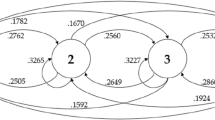Abstract
A tertiary education faculty is modelled using an absorbing Markov chain. The model takes account explicitly of full-time and part-time student stocks and flows, and thus facilitates some interesting observations. The evaluation of steady state statistics, gives rise to some worrying results, raising the question as to how efficiently resources are being utilized in tertiary (post secondary) education. The above evaluation is performed for undergraduate sections of the Faculty of Business at the Swinburne Institute of Technology (SIT), Victoria, Australia.
Similar content being viewed by others
References
Barcan, A. (1978). “Exciting times for C.A.E.'s,” Australian Quarterly 50 (1); 37–50.
Bartholomew, D. J. (1973). Stochastic Models for Social Processes. (2nd Ed.) London: J. Wiley & Sons.
Burke, G. (1972). “A study in the economics of education with particular reference to the supply of secondary teachers for government schools in Victoria,” Ph.D. Thesis, Monash University.
Committee of Inquiry into Education and Training (1979). (Williams Committee) Report. Canberra, A.G.P.S. V. 1 and 2.
Forbes, A. F. (1971). “Markov chain models for manpower systems,” pp. 131–146 in Bartholomew, D. J. and Smith, A. R. (Eds). Manpower and Management Science. London: English Universities Press.
Gani, J. (1963). “Formulae for projecting enrolments and degrees awarded in Universities,” Royal Statistical Society Journal Series A, 126: 400–409.
Handa, M. L. and Skolnik, M. L. (1975). “Unemployment, expected returns, and the demand for university education in Ontario: some empirical results,” Higher Education 4: 27–43.
Jencks, C., et al. (1979). Who Gets Ahead? New York: Basic Books.
Layard, R. and Psacharopoulos, C. T. (1974). “The Screening Hypothesis and the Returns to Education,” Journal of Political Economy 82 (5): 985–998.
Marshall, K. T. (1973). “A comparison of two personnel prediction studies,” Operations Research 21:810–822.
Miller, R. N. (1981). The Rate of Return to Education - the Findings from the 1976 Census. Centre for Economic Policy Research, Australian National University. Discussion Paper No. 25, April 1981.
Nicholls, M. G. (1982a). “Short term prediction of student numbers in the Victorian education system,” The Australian Journal of Statistics 24 (2): 179–190.
Nicholls, M. G. (1982b). “The Use of Markov and other Models in Planning in Tertiary Education in Victoria,” Ph.D. Thesis, Monash University.
Psacharopoulos, G. (1980). “Educational planning and the labour market,” European Journal of Education 15 (2): 201–20.
Sales, P. (1971). “The Validity of the Markov Chain Model fora Class of the Civil Service,” The Statistician, 20 (10): 85–110.
Stone, R. (1972). “A Markovian education model and other examples linking social behaviour to the economy,” Royal Statistical Society Journal Series A, 135: 511–32.
Thonstadt, T. (1967). “A mathematical model of the Norwegian education system,” pp. 125–128 in Mathematical Models in Educational Planning. Paris: OECD.
Uche, P. I. (1978). “On stochastic models for educational planning,” International Journal of Mathematical Education in Science and Technology 9 (3): 333–42.
Author information
Authors and Affiliations
Rights and permissions
About this article
Cite this article
Nicholls, M.G. A Markovian evaluation of a tertiary education faculty. High Educ 12, 721–730 (1983). https://doi.org/10.1007/BF00132427
Issue Date:
DOI: https://doi.org/10.1007/BF00132427




